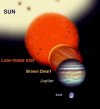tracer said:
Q: (Ark) Then I had to put another number which was not told to us. I was asking about the mass of this companion star, and I was told that it was "much less than the sun". So, in my calculations, I put half a percent of the mass of the sun. Is it approximately true?
A: 3.4, closer
I do not know whether it was already discussed somewhere but I am wandering if this body is bigger than Jupiter? And and what is it density?
Hello tracer,
As per wiki and other encyclopedias mass of the sun would be between 98% to 99% of entire mass of the solar system. Related to the mass relation of the sun and Jupiter, perhaps will be the best to explain it on this way: If we calculate mass of the sun as 99% of the mass of the entire Solar System than calculation is following:
The mass of the Sun is 1.9891 x1030 kg. I'm sure you find that a hard number to wrap your mind around, so in comparison, that's 333,000 times the mass of the Earth. And while the Earth is made up of rock, the Sun is almost entirely hydrogen and helium; the two lightest elements in the Universe.
Compared to the Sun, Jupiter is about 0.001 its mass, and is about 1/50 its diameter.
Here are some tabs from: http://www.vendian.org/envelope/dir1/earth_jupiter_sun.html
with Earth - Sun - Jupiter relations in mass, diameter, volume....,...
Clarifying size, and practice with spheres...
diameter vs Earth
Earth 107 × 1.27 m 1 x
Jupiter 108 × 1.43 m 10 x (closer to 11)
Sun 109 × 1.39 m 100 x (closer to 110)
length, area, volume
m1 m2 m3
If length (m) goes 1 : 101 : 102 (ie 1 : 10 : 100)
then area (m2) goes 1 : 102 : 104 (12 : 102 : 1002)
and volume (m3) goes 1 : 103 : 106 (13 : 103 : 1003).
diameter vs Earth
Earth 107 × 1.27 m 1 x 100
Jupiter 108 × 1.43 m 10 x 101 (closer to 11)
Sun 109 × 1.39 m 100 x 102 (closer to 110)
surface area vs Earth
Earth 1015 × 0.510 m2 1 x 100
Jupiter 1017 × 0.641 m2 100 x 102 (closer to 130)
Sun 1019 × 0.609 m2 10,000 x 104 (closer to 12,000)
volume vs Earth
Earth 1021 × 1.1 m3 1 x 100
Jupiter 1025 × 1.52 m3 1,000 x 103 (closer to 1,400)
Sun 1027 × 1.41 m3 1,000,000 x 106 (closer to 1,300,000)
diameter area volume
Earth 107 × 1.27 m 1015 × 0.510 m2 1021 × 1.1 m3
Jupiter 108 × 1.43 m 1017 × 0.641 m2 1024 × 1.52 m3
Sun 109 × 1.39 m 1019 × 0.609 m2 1027 × 1.41 m3
mass
The densities (kg/m3) are somewhat similar, so mass follows volume.
density volume mass
Earth 103 × 5.5 kg/m3 (5.5 g/cm3) 1021 × 1.1 m3 1025 × 0.60 kg x100
Jupiter 103 × 1.3 kg/m3 (1.3 g/cm3) 1024 × 1.52 m3 1027 × 1.9 kg x103
Sun 103 × 1.4 kg/m3 (1.4 g/cm3) 1027 × 1.41 m3 1030 × 2.0 kg x106
As Sao allready wrote brown dwarf could have different mass per volume than giant gas planets or stars because of different fusion fuel (Methane (older brown dwarfs), Lithium if high mass brown dwarf (this is according to our calculation small possibility) or deuterium fusion if low mass brown dwarf) and/or limited fusion processes on it's crust side except in it's core.
Attached picture from: http://www.daviddarling.info/encyclopedia/B/browndwarf.html to visualise low mass brown dwarf and Jupiter - Sun volume.




